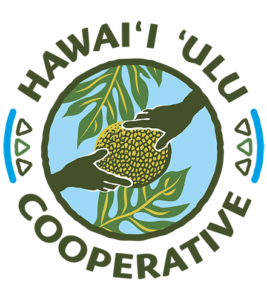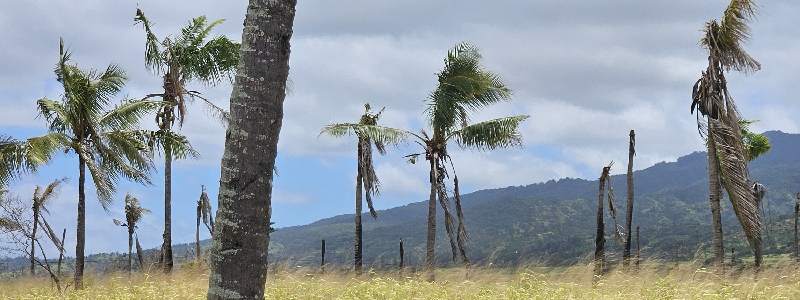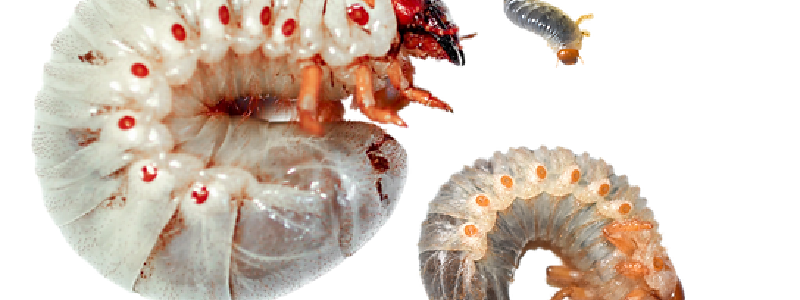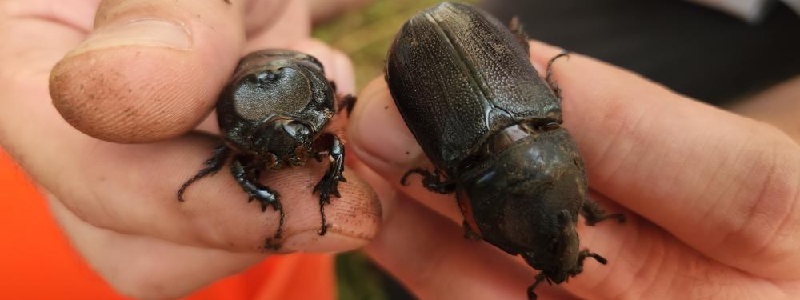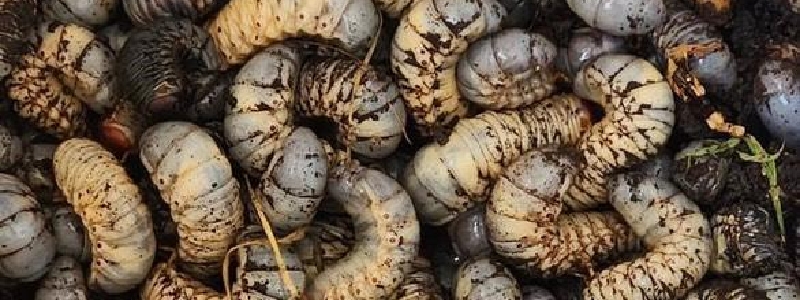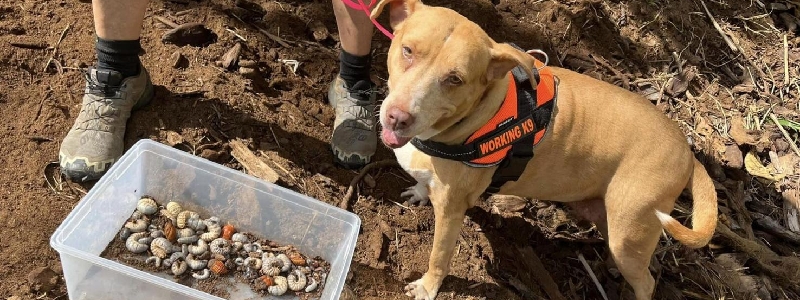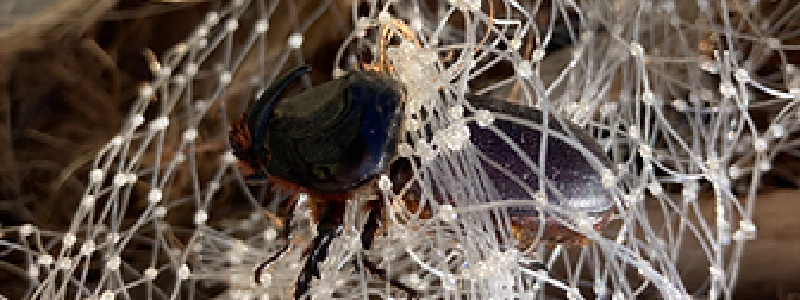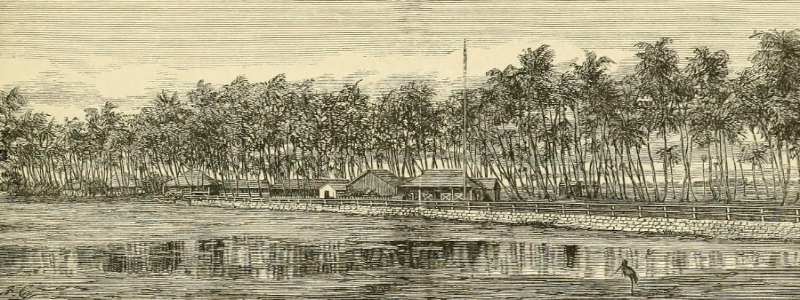Coconut Agroforestry – Part 3
Problems & Solutions – CRB (Coconut Rhinoceros Beetle)
It is impossible to talk about planting coconuts in Hawaiʻi today without discussing the CRB issue. If you have been living under a pohaku since the initial detection in 2013 and are unfamiliar with the critical bio-security threat that is the Coconut Rhinoceros Beetle – Start Here.
While the State of Hawai’i Dept of Agriculture has awarded community grants across the islands this past July to help fight the spread of CRB, nearly two months later at the time of this writing no funds have been dispersed and none of the plans put forth by community organizations have been initiated. The list of organizations awarded across the state can be found here.
A two-day virtual science symposium was held September 11&12th, 2024 with experts from around the world presenting the latest research on everything from CRB bio-controls, detection technology and trapping methods, to treatment applications using Drones. The Hawai’i ‘Ulu Co-op team tuned-in, and much of our recent learnings are outlined below. The full recordings can be found here: Day 1, Day 2
As frustrations and urgency continue to mount in communities and farms across the pae ʻāina, it is clear that more treatment options need to be considered, more Niu need to be planted, and we all need to get involved to prevent a Hawaiʻi without coconuts. This part of our Coconut Agroforestry series highlights the various strategies being used, as well as the ones we’re not using but should be considering.
CRB Treatment & Mitigation
Throughout it’s life-cycle from larvae to adult beetle, CRB will infest things like mulch, compost piles, and decaying logs, as well as the live trees we love. Thus, management strategies need to be multi-pronged to attack beetles at their different life-stages, as well as being practical for the context. (i.e. Treatment of Trees for nut production vs. Ornamental trees, or Small-farm mulch piles vs. Commercial composting facilities)
Larval Stages of the Coconut Rhinoceros Beetle – CRB Response Team website
Current Treatments
Below is a list of treatments and mitigation strategies currently being deployed and promoted by the Hawai’i State CRB Response team, along with pros & cons of each. For more details on any of these methods, visit the official CRB Response website.
- Netting
- Chemical free, physical barrier, effective entrapment
- Requires access to the crown (climbing), routine maintenance every 2-4 months
- Relatively inexpensive (local supplier: ProAct Products, O’ahu | IG: @proactproductshi)
- Sand-filled crowns
- Chemical free, physical barrier, prevents Beetle from boring into palm heart
- Inexpensive, yet requires regular re-application into crown area (climbing)
- Foliar Pesticide Sprays
- Effective at killing beetles on contact
- Both Organic and Synthetic chemical options available
- Restricted-use Pesticides require certified applicators
- Can be applied via drone
- Does not provide lasting protection
- Imidacloprid Pesticide Injection
- Effective at killing beetles once they chew on treated palm
- Expensive equipment, requires specialized training
- Toxic to pollinators, requires routine removal of flowers (every few months)
- Cannot eat nuts for over one year, causes side effects in humans
- Mulch/Compost Treatment
- Many methods of processing breeding material
- Anything from Chipping, Grinding, Hot-composting, Submerging, Steaming, Fumigating, Spreading thin, Burying, Tarping
- Some kill, some delay
- Mostly labor intensive and difficult to maintain at scale
Prospective Treatments
Biological Controls
Bio-controls use natural predators, parasites, or viruses to help control invasive pests. Hawai’i has a turbulent history with introducing species for use as bio-controls, though with proper research and protocol, bio-controls are often regarded as the best hope for effective long-term control of invasive species.
Below are a number of potential treatment methods that have proven to be an effective control in other countries, though have not yet been adopted or promoted by the Hawai’i CRB Response team. At the time of this writing, CRB Response is waiting on a State-approved containment & testing facility in order to safely research and develop some of these Bio-controls.
- Oryctes Rhinoceros Nudivirus (OrNV)
- Natural virus that infects both CRB Larvae and Beetles
- Effective CRB control when introduced to Samoa, Tonga, and Fiji
- Hawai’i CRB subtype (often referred to as CRB-G) found to be resistant to Nudivirus
- More research needed to find new effective strain of Nudivirus for Hawai’i
- Entomopathogenic Fungus Bio-control
- Native strains of insect killing fungus exist
- Effective treatment for CRB Larvae in other countries (i.e. GMF in Philippines)
- Restrictions on importing into state
- Potential lab culture process may scale production for easy distribution
- Potential for easier widespread treatment of breeding material
- Insect-parasitic Nematode Bio-control
- Potential to use native soil nematodes (Heterorhabditis indica)
- Proven effective at killing Queensland Longhorn Beetle and other insects
- Potential for treating both live trees and breeding material
- Potential for scaling-up production in lab setting for easier distribution
- May also help control other non-CRB insect pests found in mulch
- University of Hawai’i Study in 2015 found:
“The endemic strains recovered in this survey hold promise for controlling invasive insect pests and persisting after application when utilized in Hawaiian agricultural systems.”
Meyers, etc al. 2015 – Download the Full Research Paper
Chemical Controls
- Nanotek Palm Weevil Killer
- Proven long-term treatment of many palm types in other countries
- Relatively inexpensive and easy application
- Applied via drilling into Root zone of tree, one-time application treats for many years
- Claims to be non-toxic to pollinators and humans
- Currently no evidence of health study can be found for coconuts
- Not currently used or promoted by CRB Response team
Dog in training for CRB detection – Conservation Dogs of Hawaiʻi
Physical Controls
- Pigs & Dog larvae control
- Pigs are very effective at rooting through piles and eating larvae
- Access to hogs is logistically challenging and raising livestock is not realistic for everyone
- Dogs can be trained to sniff out and detect larvae
- Netted Mulch Traps
- Uses breeding material to bait adult beetles to entrapment
- Natural crushed palm heart-wood found to be more attractive than the commonly used synthetic pheromone (Oryctalure: Ethyl 4-methyloctanoate)
- Create mulch piles near hot-spots and cover loosely in 1/2 inch netting
- Placing a UV light on pile at night also found to attract Beetles
- Inspect traps regularly to collect entangled beetles and turn piles to collect larvae
- Inexpensive and no special permit required
Netting entrapment of Coconut Rhinoceros Beetle – CRB Response Team website
Reporting new CRB Detections
At the time of this article, CRB has now been detected outside of Oʻahu on Kauaʻi, Maui, and Hawaiʻi island. It will take constant surveillance and prompt communication of suspected new detections by everyone in our communities in order to prevent the beetles from spreading.
If you suspect CRB in your area, you are encouraged to:
- Report it to CRB Response Hawaiʻi
- Call your local Invasive Species Committee
- Hawaiʻi Island – (808) 933-3340
- Maui County – 808) 573-6472
- Kauaʻi – (808) 821-1490
- Oʻahu – (808) 266-7994
Take action! Use your best judgement and take preventative measures into your own hands, don’t wait until it’s too late! Together, we can beat this beetle and make coconuts a common staple food for all of Hawaiʻi again. Because as the NIU NOW hui knows…
Kupu ka Niu, kupu ke kanaka.When coconuts grow, humanity flourishes.
Sketch of a Coconut Grove at Kamehameha V estate, Waikiki circa 1875 (Images of Old Hawai’i)
